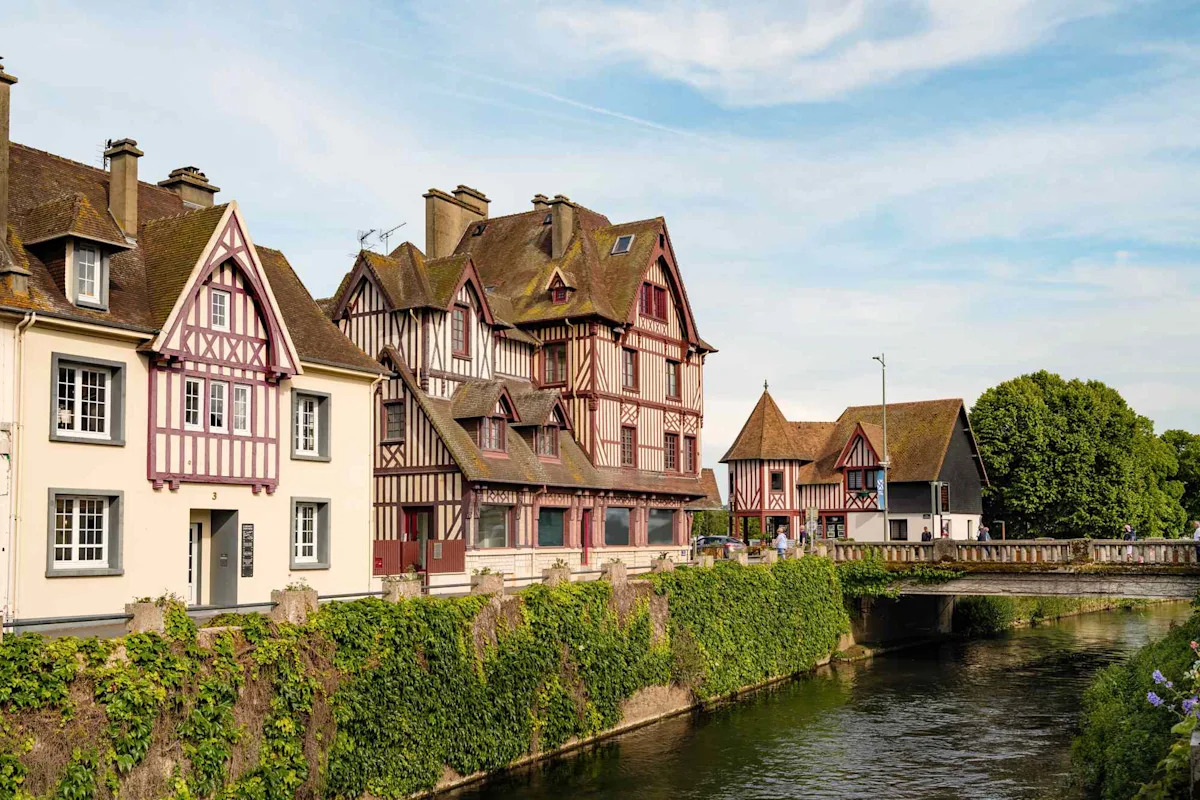Fortifiez-moi avec des pommes; car je suis malade d’amour.
This line from the Song of Songs appears on a plaque in the orchard of Calvados Christian Drouin. “Refresh me with apples,” goes the translation, “for I am sick with love.”
Like Champagne and Cognac, Calvados is both a drink—in this case, apple brandy—and a place. The département, one of the five that make up Normandy, covers 2,100 square miles, with a majestic Atlantic coastline unspooling from the Seine estuary to the World War II battlefield of Omaha Beach. Lush cow pasture (cheese is another of the area’s culinary calling cards) and tidy orchards cover the interior.
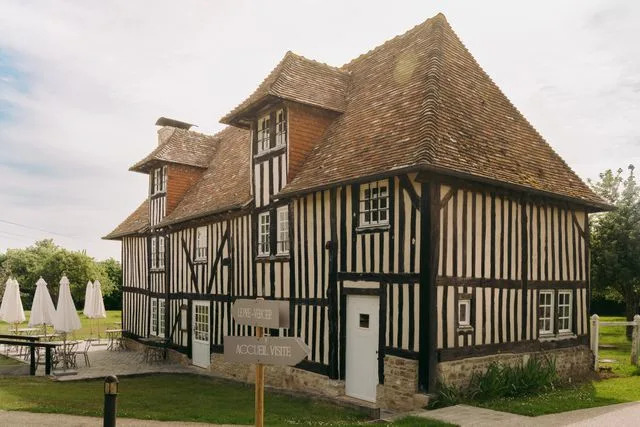
Alex Crétey Systermans
A classic half-timbered building on the grounds of Calvados Christian Drouin, in Pont-l’Évêque.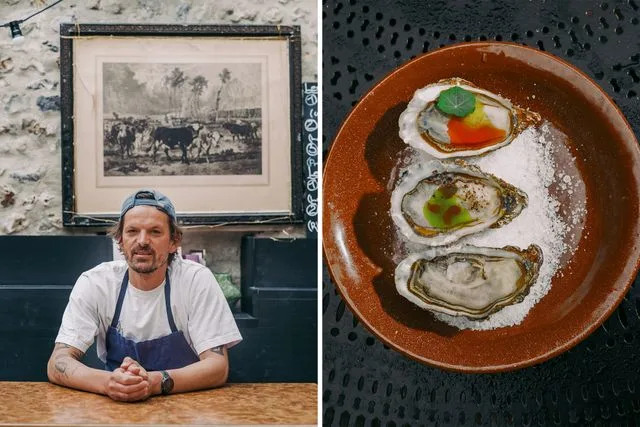
Alex Crétey Systermans
From left: Paul Lacheray, chef of the Honfleur restaurant Huître Brûlée; oysters at Huître Brûlée.
Since the 1960s, the Drouin family has been distilling the fruits of the land in the heart of the Pays d’Auge, the most exacting of the three appellations in which Calvados can be produced. But when Guillaume Drouin joined the family business in 2004, it was the drink’s reputation that needed refreshing. “It had a dusty image,” he told me. “It was the bottle of your grandfather.”
Drouin’s own grandfather, Christian, started as a hobby distiller. By the 1980s, when Drouin’s father, Christian Jr., began bottling, “Calvados was still very regional,” he said. “Most of it would end up in a cup of coffee.” Drouin joined the business with a mandate to update the spirit’s public perception while protecting the family legacy. “That makes our work interesting. How do you innovate in a very traditional industry?”
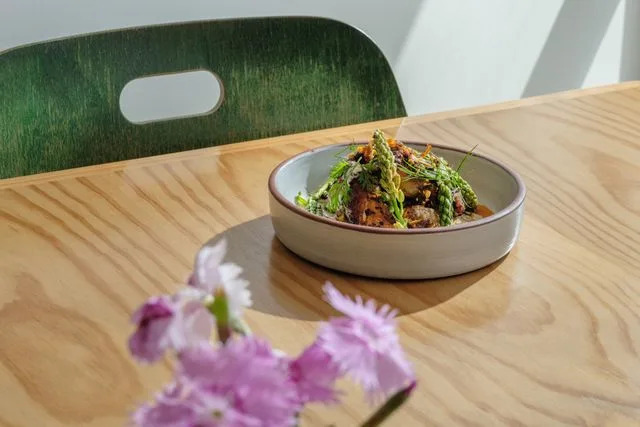
Alex Crétey Systermans
Octopus with asparagus and yogurt at Aux Saint Jus, in St.-Julien-le-Faucon.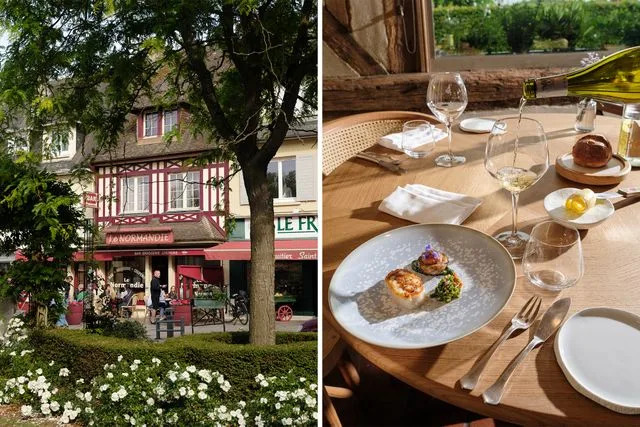
Alex Crétey Systermans
From left: A street scene in Pont-l’Évêque; sole with artichokes and olives at Ferme Saint Siméon, an inn in Honfleur.
Tradition begins with the apples, 35 heirloom varieties selected over the centuries for natural pest resistance: blush-cheeked Bedans, squat chartreuse Domaines, pink Noel Deschamps stippled with goose bumps.
On my October visit to the distillery—located 10 minutes inland from the toylike Trouville-Deauville station, a two-hour train ride from Paris—the harvest was just getting under way. At the Drouin complex, fruit covered the trees and littered the grounds. After tasting some seductive old-barrel brandies, I got swept up, unexpectedly, in an exquisite gin made from the same apples and layered with raspberries and lemon.
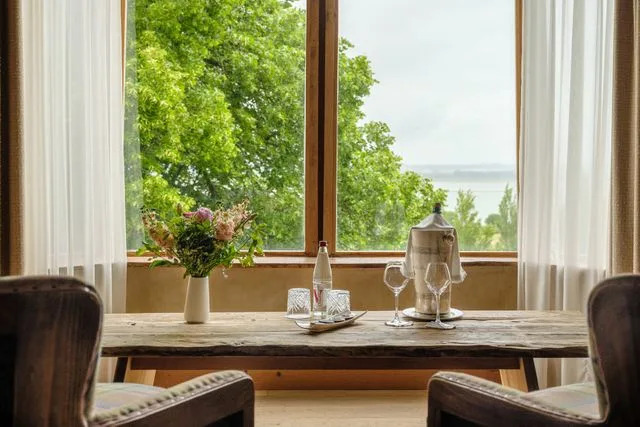
Alex Crétey Systermans
A view of the Seine from a suite at Ferme Saint Siméon.
Tradition and history have been the main currency in Normandy for generations. You can’t go there and not do the World War II circuit. Thanks to Scottish-born historian Iain Hennelly, owner of Normandy on Tour, I spent a whirlwind afternoon that began at the Musée du Débarquement, a stark concrete-and-glass box in Arromanches-les-Bains, the village fronting the British Allied landing site of Gold Beach. At Arromanches 360° Circular Cinema, I took in an emotional short film featuring interviews with D-Day survivors. From there, I walked along Omaha Beach, where on June 6, 1944, German gunners camouflaged on the cliffs killed an estimated 2,000 members of the 1st and 29th infantry divisions on this six-mile shoreline. “It wasn’t the ocean that gave it the nickname Bloody Omaha,” Hennelly said, “but the sand turning red.”
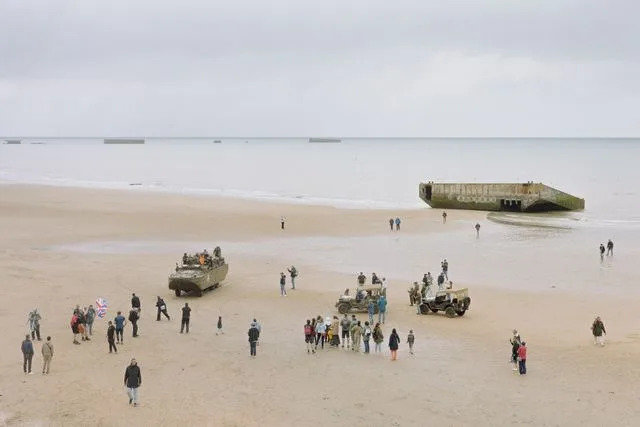
Alex Crétey Systermans
Commemorating D-Day on the beach in Arromanches-les-Bains.
As a traveler, you can never escape the gravity of Normandy’s past. But the region does a wonderful job of acknowledging what happened there, while also celebrating what is happening there. Throughout the départements, I found the past and present in an ongoing dialogue. In tony Deauville, I retraced the steps of the old Franciscan nuns who used to inhabit the grand convent that’s become Les Franciscaines cultural arts center. At Restaurant de L’Île Benoist, in Courseulles-sur-Mer, I pried chilled periwinkles and whelks from their corkscrew shells in a dining room overlooking the oyster ponds that chef Sébastien Benoist’s family has farmed since the 1950s.
In Honfleur, a harbor town favored by the Impressionists, I stayed at Ferme Saint Siméon. The family-owned Relais & Châteaux inn has a gracious lawn overlooking the estuary, bathrooms furnished with steam showers and full-size Molton Browns, and a hygge tavern, Bistro Le Boucane. The old loft above the restaurant was the winter address of Claude Monet, who painted four snowscapes of the road outside the erstwhile inn in the late 1860s.
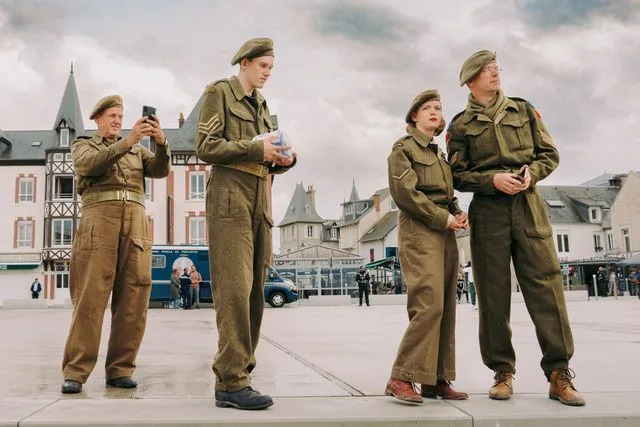
Alex Crétey Systermans
World War II enthusiasts in Canadian uniform outside the Musée du Débarquement, in Arromanches-les-Bains.
From Saint Siméon, I followed the same route Monet would have walked, down into Honfleur, a knot of galleries and candy shops around a picturesque marina where the Seine drains into the Atlantic. Before opening Huître Brûlée in 2018, chef Paul Lacheray, who grew up in Honfleur, and his wife, Chloe Woestelandt, would go to Paris to eat in ingredient-conscious, natural-wine-pouring bistros and lament that they couldn’t find something similar back home. They wondered, Could we do this in touristy Honfleur? “In the beginning,” Lacheray said, “everyone told us, ‘You’re crazy, don’t do that.’ ”
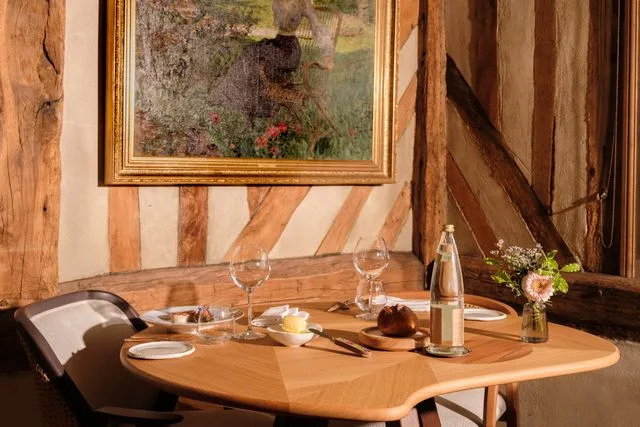
Alex Crétey Systermans
A corner of the dining room at Ferme Saint Siméon.
The couple didn’t listen. They now tend a charming bolt-hole with bouquets of dried eucalyptus and ivory roses hanging from the stone walls. Just inside the front door, I passed Lacheray hovering over veal kidneys and scallop crudo in the glowing open kitchen. I got the oysters, of course, but I still think about my order of Venus clams, steamed in warm cream with citrusy-floral makrut lime.
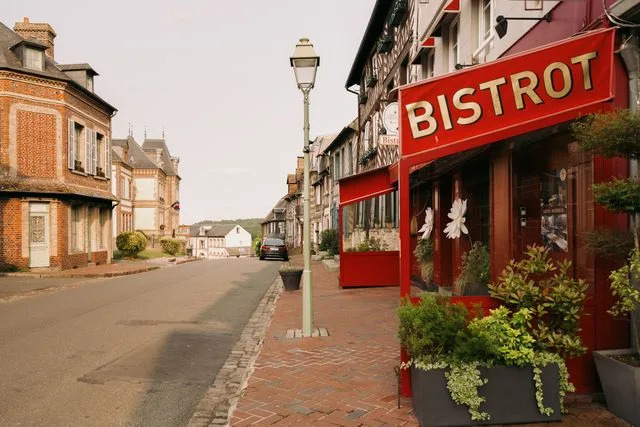
Alex Crétey Systermans
The main street of the village of Beaumont-en-Auge.
The next day, I asked Lacheray for his favorite spots in the region, and he sent me an hour south to Aux Saint Jus, in St.-Julien-le-Faucon, a no-stoplight town of 745 souls. “Normandy is getting better and better outside the touristic places,” he explained, adding that the less expensive real estate in the countryside allows newcomers to experiment. That tracked with my experience. However much I identified with the bronzed grand-pères obstinately soaking up every last ray of autumn sun on the beach, I kept retreating inland.
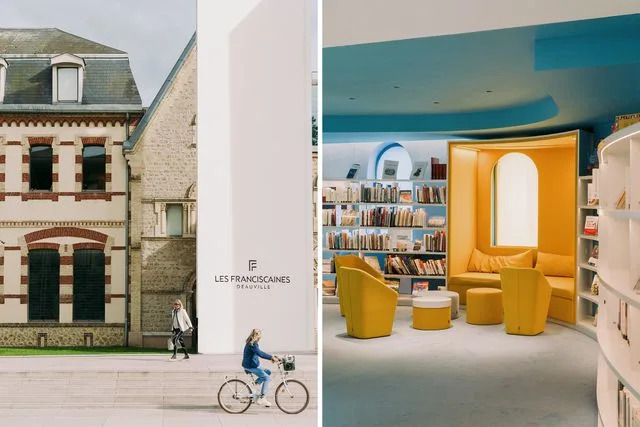
Alex Crétey Systermans
From left: The entrance to Les Franciscaines, an arts center in Deauville; the building’s library.
Eccentric characters inhabit the rural villages of the Pays d’Auge, where storybook bridges cross rushing streams and the lampposts are swallowed by blue morning glory. In Beaumont-en-Auge, I encountered the kaleidoscope craftsman Dominic Stora fussing over fragments of mirrored glass in a white optician’s coat in his shop, Après la Pluie. In Pont-l’Évêque I met David Raguet, a golf pro who decided to trade tee times for cheese rinds and opened Fromagerie La Dégusterie a few years ago.
At Aux Saint Jus, meanwhile, chef Pablo Jacob and sommelier Guillaume Armand are quietly turning St.-Julien into a culinary destination. Even though, as Jacob told me, the coast still gets the bulk of Normandy’s visitors, “we usually have to say no to at least ten people every service because we don’t have enough space.”
The sun-washed dining room was white and green as a head of romaine and was stacked with wine for retail sale. A chalkboard name-checked the provenance of the house-butchered animals, and there were enough jars of preserved lemons and cornichons to brighten a year of tagines and charcuterie boards. I got lost in a bowl of split-pea, the homeliest of soups, glowed up with crackles of house-made pancetta, lots of good olive oil, and fresh cilantro and dill. Around me, veterinarians, stonemasons, and remote-working Parisians filed in for the well-priced set lunch.
“After COVID, instead of buying a small apartment in Paris, a lot of people bought a house in the country,” Jacob said. (He and his wife were among them.) “The region used to be considered in an economic decay, but now there’s a new dynamic going on.”
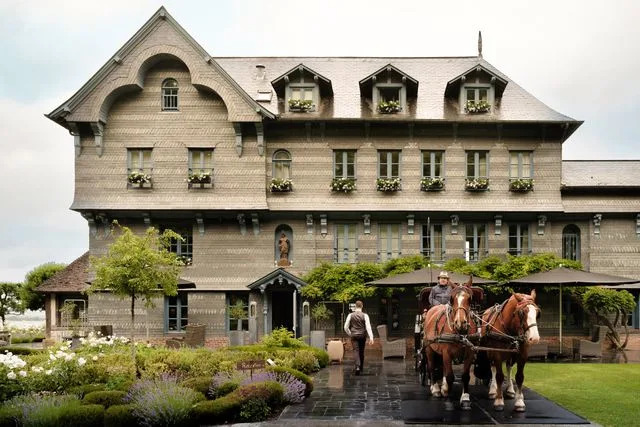
Alex Crétey Systermans
The main building at Ferme Saint Siméon, in Honfleur.
I left Aux Saint Jus refreshed—not with apples but with whole-wheat pasta whose spiral curves caught shreds of succulent braised beef; with spiced and roasted pumpkin in a porridge of red lentils; and, most importantly, with that serial traveler’s thrill of discovering gold in the middle of nowhere.
A version of this story first appeared in the September 2025 issue of Travel + Leisure under the headline “Fruit Forward.”
Read the original article on Travel & Leisure
